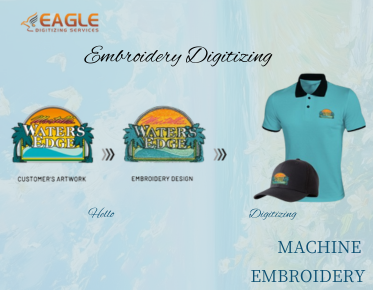Tips for Successful Embroidery Digitization
Digitizing embroidery designs in Photoshop is a multifaceted endeavor that transcends mere tracing. It demands meticulous attention to detail and deep comprehension of how digital elements will manifest as physical stitches on fabric. Beyond basic digitization techniques, mastering this craft involves refining each design element to optimize its appearance and functionality in embroidery. Here are essential tips to elevate your digitization process:
1. Understand Stitch Types
Satin Stitch: Ideal for smooth, continuous lines and small lettering, satin stitches consist of closely packed threads that create a shiny, smooth surface. This stitch type is perfect for adding a polished and professional look to your embroidery designs. For instance, when digitizing text or logos, the satin stitch can enhance the elegance of the letters and outlines by providing a clean, glossy finish. To achieve the desired effect, adjust stitch density and direction. It's crucial to ensure the stitches are not too dense, as this can cause puckering, where the fabric gathers and distorts the design. Conversely, if the stitches are too sparse, the design may lack clarity and definition. A balanced density will result in a visually appealing and durable embroidered element.
Fill Stitch: Used for larger areas requiring solid coverage, fill stitches (also known as tatami or ceding stitches) fill in designated areas with closely packed stitches. This stitch type is ideal for backgrounds, large shapes, or solid color areas within a design. For example, if you are digitizing a large floral pattern, fill stitches can be used to cover the petals, providing a consistent and smooth appearance. Adjust the stitch angle and density to achieve optimal coverage and texture. This ensures the design looks uniform and defined without gaps or inconsistencies. By varying the stitch angle, you can add depth and dimension to the design, making it more visually interesting and dynamic.
Running Stitch: Often used for outlining or creating fine details, running stitches are simple and quick, consisting of single stitches along a path. This stitch type is essential for adding intricate details and outlines to your design. For instance, running stitches can be used to define the edges of a logo, adding sharpness and clarity without adding bulk. Additionally, they can be employed to create delicate patterns within a larger design, providing subtle accents and enhancing the overall complexity. Adjust the stitch length to control the appearance of lines and details in your design. Shorter stitch lengths can create smooth curves and detailed lines, while longer stitches are suitable for straight lines and less intricate details. This flexibility makes running stitches a versatile tool in embroidery digitization.
By understanding and effectively utilizing these stitch types, you can enhance the quality and precision of your embroidery designs, ensuring they translate beautifully from digital artwork to embroidered fabric. Mastery of these stitches allows for greater creativity and control, resulting in embroidery that is both aesthetically pleasing and technically sound.
2. Optimize for Fabric and Thread
● Consider the type of fabric you'll be embroidering on and adjust your digitized design accordingly. Different fabrics have unique characteristics that affect how stitches lay and how the final design appears. For example, lightweight fabrics like silk or chiffon may require a lower stitch density to prevent puckering and distortion. In contrast, heavier fabrics like denim or canvas can support higher stitch densities and more complex designs without compromising the integrity of the fabric. When digitizing your design, take into account the fabric's texture, stretch, and thickness. For instance, if you are embroidering on a stretchy knit fabric, you might need to use stabilizers and adjust your stitch types to accommodate the fabric's movement and prevent the design from becoming misshapen.
● Choose thread colors that complement your design and fabric. Selecting the right thread colors is crucial for achieving a harmonious and visually appealing embroidery piece. Photoshop allows you to experiment with different color combinations digitally before committing to embroidery. Utilize Photoshop's color tools to preview how various thread colors will look against your chosen fabric. This feature helps ensure that your final product meets your expectations in terms of color balance and visual impact. For example, if your design includes a logo with multiple colors, you can use Photoshop to test different thread shades and see how they interact with the fabric's background color. This digital experimentation can save time and resources by preventing mistakes and ensuring a cohesive and attractive final product.
By optimizing your digitized design for the specific fabric and thread colors you plan to use, you can enhance the overall quality and professionalism of your embroidery projects. This attention to detail ensures that your designs look crisp, clear, and aligned with your artistic vision, regardless of the fabric or color scheme you choose.
3. Layer Management and Editing
● Keep your design organized using layers in Photoshop. Layers are essential for managing complex designs and ensuring that each element is easily editable. By separating different parts of your design into individual layers, you can isolate specific areas for adjustments without altering the rest of the design. For example, if you are working on a logo with text and an icon, place the text on one layer and the icon on another. This allows you to fine-tune the text’s positioning, font, and size independently of the icon, and vice versa. Additionally, using layers helps you keep track of different design elements and their respective settings, making the digitization process more efficient and less prone to errors. Organizing your design in layers also facilitates color changes and modifications, enabling you to quickly experiment with different looks and effects.
● Use Photoshop's editing tools to refine details, adjust shapes, or smooth edges as needed. Photoshop offers a robust set of tools specifically designed to help you perfect intricate parts of your design. The Path Tool, for instance, is ideal for creating precise outlines and curves, allowing you to trace elements of your design with accuracy. This tool is especially useful for refining the edges of shapes or letters, ensuring they are smooth and well-defined. The Brush Tool can be used to add fine details or touch up areas that need a bit more attention. For example, if your design includes a detailed floral pattern, you can use the Brush Tool to add texture and depth to the petals and leaves. Additionally, features like the Eraser Tool and Smudge Tool can help you clean up any rough edges or unwanted marks, ensuring that the final digitized version is as polished as possible. By leveraging these editing tools, you can enhance the clarity and precision of your design, resulting in a high-quality embroidered product that faithfully reproduces your original artwork.
Overall, keeping your design organized in layers and using Photoshop's editing tools to refine details are crucial steps in the embroidery digitization process. These practices not only streamline your workflow but also ensure that your final embroidered piece looks professional and meticulously crafted.
4. Test and Refine
Before proceeding with full-scale production, test your digitized design on a sample piece of fabric. This crucial step allows you to evaluate how your digital design translates into physical stitches and ensures that any potential issues are identified early on. Choose a fabric that closely matches the one you will use for the final product, as different fabrics can affect the appearance of the embroidery. For example, if your final piece will be on cotton, conduct your test on a similar weight and texture of cotton fabric. By stitching out a sample, you can see firsthand how well the design elements, such as lines, shapes, and colors, are rendered by the embroidery machine. This preliminary test helps you avoid costly mistakes and ensures that the final production run meets your quality standards.
Analyze the test stitch-out for issues such as thread tension, stitch density, and overall appearance. Carefully examine the test embroidery to identify any problems that could affect the final product. Look for issues like improper thread tension, which can cause puckering or loose stitches, and assess the stitch density to ensure it is neither too tight nor too loose. A dense stitch might lead to fabric distortion, while a sparse stitch might not cover the fabric adequately. Pay close attention to the overall appearance of the design, checking for clarity and accuracy in the details. For instance, ensure that small text remains legible and that intricate patterns are well-defined. If you notice any inconsistencies or flaws, take note of them for further refinement.
Make adjustments in Photoshop based on your findings to achieve the best possible results in subsequent production runs. Use the insights gained from the test stitch-out to refine your design in Photoshop. If you observed that certain areas were too dense, adjust the stitch density or change the stitch type to better suit the fabric. For example, switch from a fill stitch to a satin stitch for smoother, less dense coverage in certain areas. If the design’s edges appeared jagged or unclear, use Photoshop’s editing tools, such as the Path Tool or Brush Tool, to smooth and refine these elements. Adjust thread colors digitally to ensure they complement the fabric and enhance the design's visual impact. By making these modifications, you can optimize your design for embroidery, ensuring that the final production pieces are of the highest quality.
By testing your digitized design on a sample fabric and analyzing the results, you can make informed adjustments in Photoshop to perfect your embroidery. This iterative process ensures that your final product is both visually appealing and technically sound, reflecting the precision and care invested in the digitization process.
5. Documentation and Backup
Document your digitization process, including settings and adjustments made in Photoshop. Keeping a detailed record of your digitization workflow is essential for consistency and efficiency in future projects. Start by noting the initial design elements, such as the dimensions of the artwork, the stitch types used (e.g., satin stitch, fill stitch, running stitch), and any specific settings applied to these stitches. Record each step taken in Photoshop, including the creation of layers, adjustments to stitch density, and any refinements made to the design's details. Include screenshots or annotated images to illustrate key stages of the process. This documentation acts as a valuable reference, allowing you to replicate successful techniques or troubleshoot issues that arise in subsequent projects. Additionally, having a well-documented process makes it easier to hand off the project to a colleague or revisit the design later for modifications or updates.
Backup your digitized files regularly to prevent loss of work and ensure you have access to the original files for future use or re-digitization if necessary. Regularly backing up your work is crucial to safeguarding your digitized designs against data loss due to hardware failures, accidental deletions, or other unforeseen events. Establish a routine for backing up your files, whether daily, weekly, or after significant milestones in the digitization process. Utilize multiple backup methods, such as saving files to an external hard drive, cloud storage services, or a dedicated server. Ensure that you back up not only the final digitized files in formats compatible with your embroidery machine (e.g., .pes, .dst, .exp) but also the original Photoshop (.psd) files. This practice guarantees that you retain all editable elements and layers, allowing for easy adjustments or re-digitization if needed. By maintaining secure, organized backups, you protect your work and ensure continuity in your embroidery projects, enabling you to revisit and refine designs as necessary without starting from scratch.
By following these tips and practicing regularly, you can improve your skills in digitizing embroidery designs in Photoshop. Attention to detail, experimentation with different techniques, and thorough testing will contribute to producing high-quality embroidered products that meet your creative vision.


